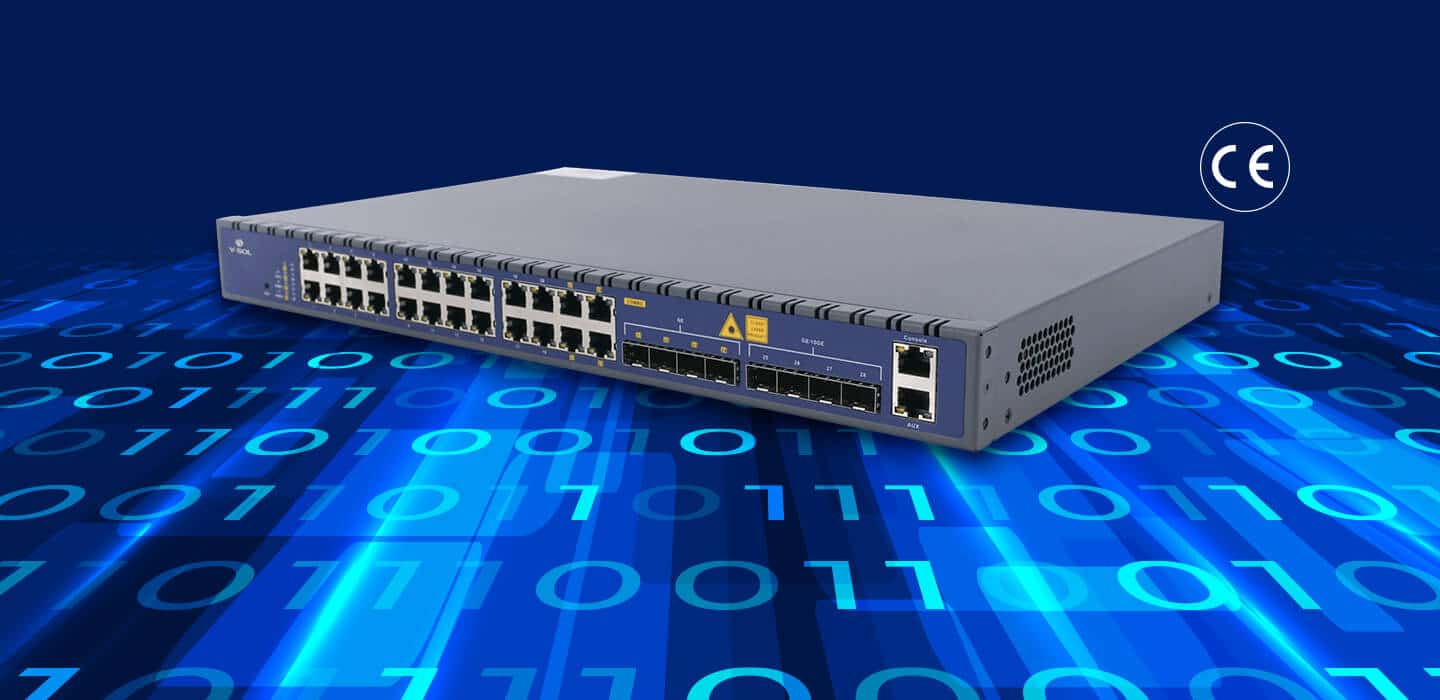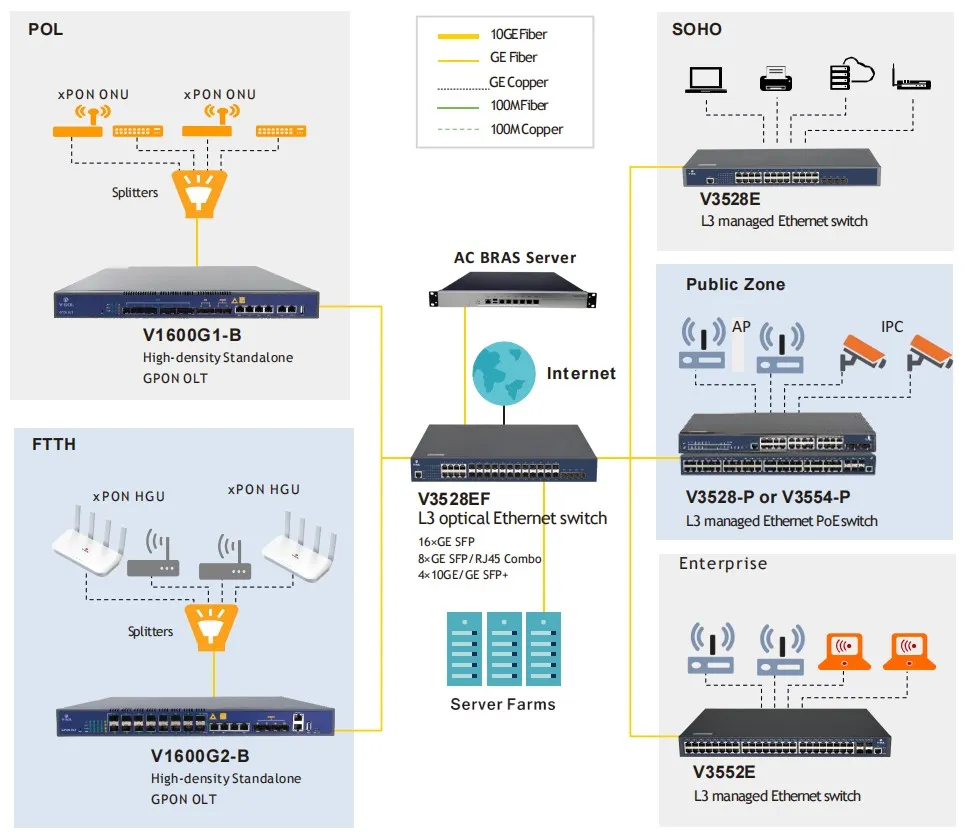The development of network interconnection is promoted with the increase of sites in the network, the expansion of geographical scope, and the growth of the business. Therefore, special connection equipment is required for achieving network interconnection including the data transmission between LANs and sharing the network resources. Thus, the switch is created.
Part I. What is Switch in Computer Network?
Generally speaking, the switch is a device for exchanging information in the computer network of the telecommunication system. Switch focuses on physical addressing, network topology, error check, frame sequence, and traffic control. The most common switch is the Ethernet switch. It can connect to multiple devices such as computers, wireless access points, printers and servers.

Working Principle of Switch:
1. According to the source MAC address received in the data frame, the switch establishes the address’s mapping with the switch port and writes it into MAC address table.
2. The switch decides which port to forward by comparing the destination MAC address in the data frame with the established MAC address table.
3. If the destination MAC address in the data frame is not in the MAC address table, it will be forwarded to all ports. This process is called flooding.
4. Broadcast frames and multicast frames are forwarded to all ports.
Part II. Types of Switch in Computer Network
❗ First of all, in the light of ISO structure, switch can be divided into Layer 2 switch and Layer 3 switch.
● Layer 2 switch
Layer 2 switch functions on the second layer of the data link layer. It’s capable of identifying the MAC address of the data frame, transmitting according to the MAC address and recording these MAC addresses and corresponding ports into the inside addresses table.
● Layer 3 switch
Layer 3 switch works on the network layer of OSI, which can be considered as a Layer 2 switch with Layer 3 routing features. But it’s an organic combination but simply adding the firmware and software of routers into the LAN switch.
For more detailed introduction, you can turn to the article talking about Layer 2 vs Layer 3 Ethernet switch.
❗ Secondly, in terms of the different functions of the switch, it can be classified as managed switch, unmanaged switch, PoE switch and LAN switch.
● Managed Switch
Managed Switch is aimed to promise a well-running network. The managed switch provides various methods of network management. Therefore, the network operator is able to monitor the status of the switch and network locally or remotely.
● Unmanaged Switch
Unlike managed switches, there is no need for unmanaged switches to configure. An unmanaged switch is usually used in basic network connections. For example, it’s applied in your office, or meeting room.
We’ve described the difference between managed and unmanaged switches in this article: Managed vs Unmanaged Switch, What’s the Difference?
● PoE Switch
What makes PoE switch different from a general switch is that can it not only transmit data but also provide AC power for the devices connected. For example, The monitor is able to function by connecting to the power after connecting to the switch, which requires a power supply or cabling around the monitor and occupies much more space. Moreover, short-circuit, fire, and electric shock may happen due to trampling or irregular operation.
● LAN Switch
LAN switch refers to switching data in switch LAN.
In traditional Ethernet, only one site can deliver data to the network at any time. Other sites have to wait for delivering data. Therefore, the fixed bandwidth of sharing Ethernet is shared by all sites and occupied randomly. The more sites in the network, the narrower the average bandwidth available to each site, and the slower the network’s response time.
Exactly, the switch solves the problem. With the LAN switch, the data can be sent parallelly when the source node and destination node don’t clash, which improves the transmission rate largely.
❗ At last, according to the network structure and the placement of switch, there are core switch, aggregation switch and access switch. What we need to notice is that it’s categorized in accordance with the role that switch plays. For example, when the VSOL Layer 3 Ethernet switch is applied at the aggregation layer, it’s an aggregation switch. It would be an access switch if it works at the access layer.
● Access Switch
The access layer aims to enable terminal users to access the network, which makes access switch low cost and high density of ports. It’s also responsible for user management like address and user certification and collection of user information such as IP address, MAC address and visit history. It’s common in life and used widely in the general office, small computer room, multimedia production center, etc. In terms of transmission speed, most modern access switches provide multiple ports with 10M/100M/1000M adaptive capability.
● Aggregation Switch
The aggregation switch is the converging point of multiple access switches, which is a critical media. It contributes to uniformly exporting AP, transmitting and routing. Compared with the access switch, the aggregation switch needs higher transmitting performance in that it should be able to handle all traffic from the access devices and forward them to the uplinks of the core layer. In addition, the aggregation switch is Layer 3 switch.
The aggregation layer switch is the aggregation point of multiple access layer switches. It must be able to handle all traffic from the access layer devices and provide uplinks to the core layer, so the aggregation layer switch needs to have high forwarding performance compared to the access layer switch, which is usually a layer 3 switch.
● Core Switch
The core layer is the network backbone, which guarantees the whole network’s performance. Core switch is one of core devices besides the router, firewall and others. Thus, it requires core switch with higher reliability, performance and throughput.
Part III. Application of Switch in Networking
Here we will introduce the application of switches in networking by taking examples with VSOL V35XX series switches. All of them are Layer 3 managed Ethernet switches.
The switches support ACL, selective QinQ, 1:1 and N:1 VLAN switching, Ethernet OAM, carrier-level QoS, industry-level 10G Ethernet ring, etc.

As shown in the above frame, Layer 3 optical Ethernet switch V3528EF is placed at the aggregation layer. It’s deposed in the server room and uplinks to the AC BARS server and downlinks to access switches.
There are 16GE SFP, which exactly connects to the SFP of other access switches like V3528E and OLT like V1600G1-B. The RJ45 connects to terminal devices. The application of POL and FTTH is similar to what we introduced before. You can refer to the following related articles.
Passive Optical LAN (POL) Overview: Advantages and Solution
FTTH Network: Application of GEPON Outdoor Reverse PoE ONU
Notes:
BARS is a bridge between the access network and the core network. It’s a gateway that controls the export and import of users’ data to the core network.
In the application of SOHO, the access switch can adopt VSOL Layer 3 network switch V3528E. The switch has 24*GE (RJ45) ports and 4*GE/10GE (SFP+) ports. It directly connects to PCs, printers, and routers with cooper.
As for public zone such as highway tunnels, you can use the VSOL managed Layer 3 PoE switch V3528-P. What makes it different is that it supports PoE power supply, which fits scenarios without electricity. It can connect to APs and IPCs.
When it comes to the application in the enterprise, Layer 3 managed Ethernet switch V3552E would be a good choice. It has 48*GE (RJ45) ports and 4*10GE/GE (SFP+) ports.
Now, have you learned more about switch in the computer network? Are you looking for Layer 3 managed Ethernet switch? VSOL Switch is the way to go!